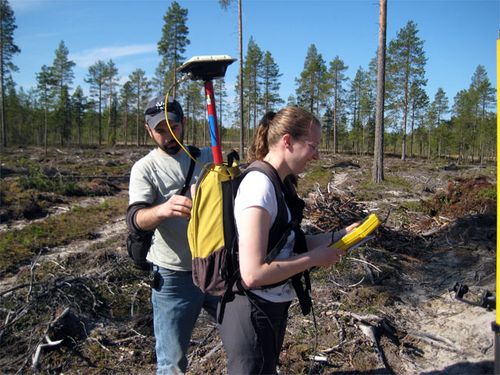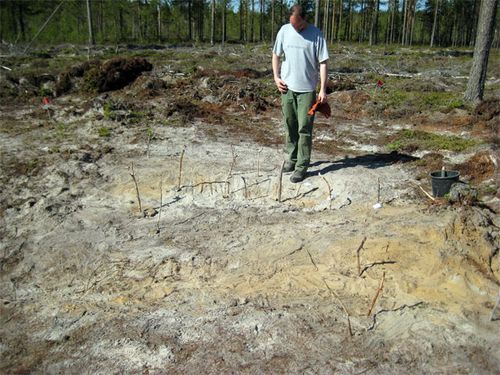Today we began to uncover a large and impressive site on a hillside in Haukipudas, north of Oulu. It has at least fifty pits! Each pit represents a dwelling. Plus, the site is "loaded” with artifacts: you can see **quartz flakes**, **quartz cores** (bigger stones from which flakes were removed) and piles of fire-cracked stones that represent **hearths** all over the ground. Five thousand years ago the site was on a sandy beach near the river mouth, next to deep water, protected from the waves by a small headland and backed by forest. It’s easy to see why people lived there.
This site is called Hiidenkangas which literally means "Heathen’s Clearing” but has a connotation sort of like "Devil’s Hill.” Apparently the locals understood that the pits were dug by prehistoric people, and didn’t much like it.
 Hiidenkangas ("Heathen's Clearing" or "Devil's Hill) clear-cut site
Hiidenkangas ("Heathen's Clearing" or "Devil's Hill) clear-cut site
There’s only one problem with this site: it has been clear-cut using heavy machinery!
 The damage to the environment and to the archaeological site looks serious. It makes you feel sick to see it.
The damage to the environment and to the archaeological site looks serious. It makes you feel sick to see it.
The trees are all gone and the forest floor has been churned up. The place looks terrible. Artifacts have been ripped "out of context”, which is an archaeologist’s way of saying they are not necessarily where the prehistoric people left them.
It just makes me sick to see all this destruction, and I am not only talking about the archaeological site! A nice Finnish forest has been ruined. A lot of forestry in Finland is not like this. People walk into the woods, select individual mature trees for cutting, trim them and haul out the logs without disturbing the soil or the surrounding trees.
So why are we here? There are a number of reasons. The site is important. The Finnish National Board of Antiquities wants us to look at it. At lot of archaeology is rescue archeology like this. In fact, a very important question in this field is "how can we obtain the information we need from disturbed sites?”
 Hiidenkangas site
Hiidenkangas site
Plus, it is really easy to see where the soil has been churned up and where it hasn’t been. Some of the pits still have their topsoil (leaf litter and A horizon) intact. These areas haven’t been disturbed at all.
 Hiidenkangas site
Hiidenkangas site
We began the hard and dirty work of stripping the turf and organic material off two squares, one high on the slope and one lower down. The upper square has lots of rocks and quartz flakes and a few stone tools, scattered all over in no discernable pattern. It was once a dwelling site, but later it might have been an outdoor workshop for stone chippers.
 Hiidenkangas site
Hiidenkangas site
I work on the lower square, removing organic material from the surface all morning in the bright sun and not finding a single thing. There are no stones here at all – just sand.
But after lunch, things suddenly change. One by one, I uncover stones until there are more than two dozen. Every one of them has been altered by humans! Most are fire cracked rock: ordinary granite cobbles that show "crazing” and patterns of cracks from being heated in a fire. There is also a quartz flake, a piece of a core, and what looks like a broken stone wedge used for splitting wood. There are at least five kinds of stone represented: granite, quartz, quartzite, gabbro, and phyllite (I think.) It’s a good thing I have a geology background. I know what ordinary rocks look like, and I can tell that these shapes and textures are not natural.
 Hiidenkangas site
Hiidenkangas site
 Hiidenkangas site
Hiidenkangas site
A very interesting pattern emerges. The field of rocks (I call it the "rock garden”) describes an "L” shape, bending around the corner where the pit house was. The living floor itself is clean. The entrance to the house is on the downhill side, facing the water. Near the entrance on the outside there are more quartz flakes.
 Hiidenkangas site
Hiidenkangas site
Professor **Andre Costopoulos** says this pattern is a "100% replica” of a pattern we’ve come to expect from other sites of the same period like those at the **Kierikki Stone Age Center**. The rocks I am finding were thrown away, along the back and side of the house away from the living space and the entrance.
 Hiidenkangas site
Hiidenkangas site
What this all appears to mean is that (1) the clear-cutting didn’t mess up the site very badly after all, and (2) the lower square was the home of a stone age culture we’ve come to recognize.
This is all from the first day. By this time tomorrow we may think something different.
Update on May 19: It's still true that the site is exactly as expected. It is important to note that although heavy machinery drove all over it and ripped up soil, the tree stumps themselves at this site have not been bulldozed. If they had been (as is often the case in North America) the site might have been compromised.

